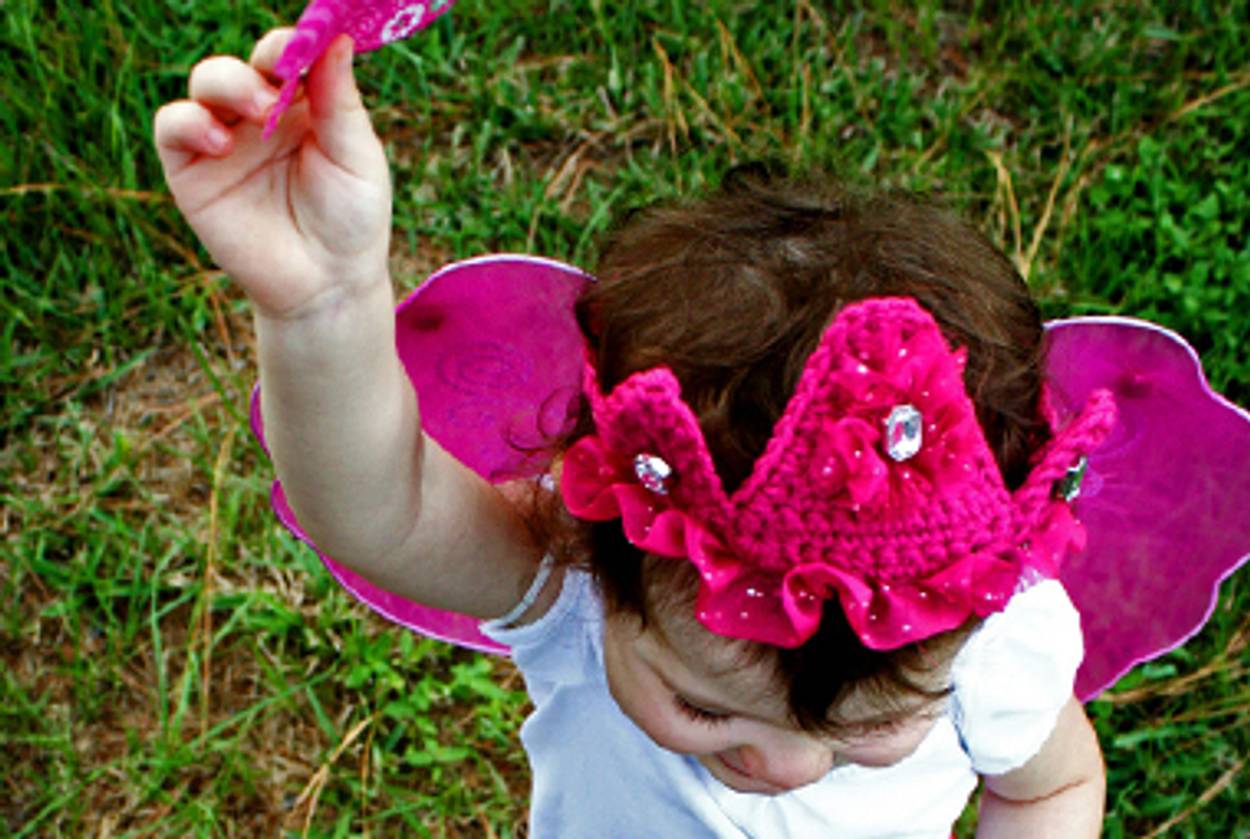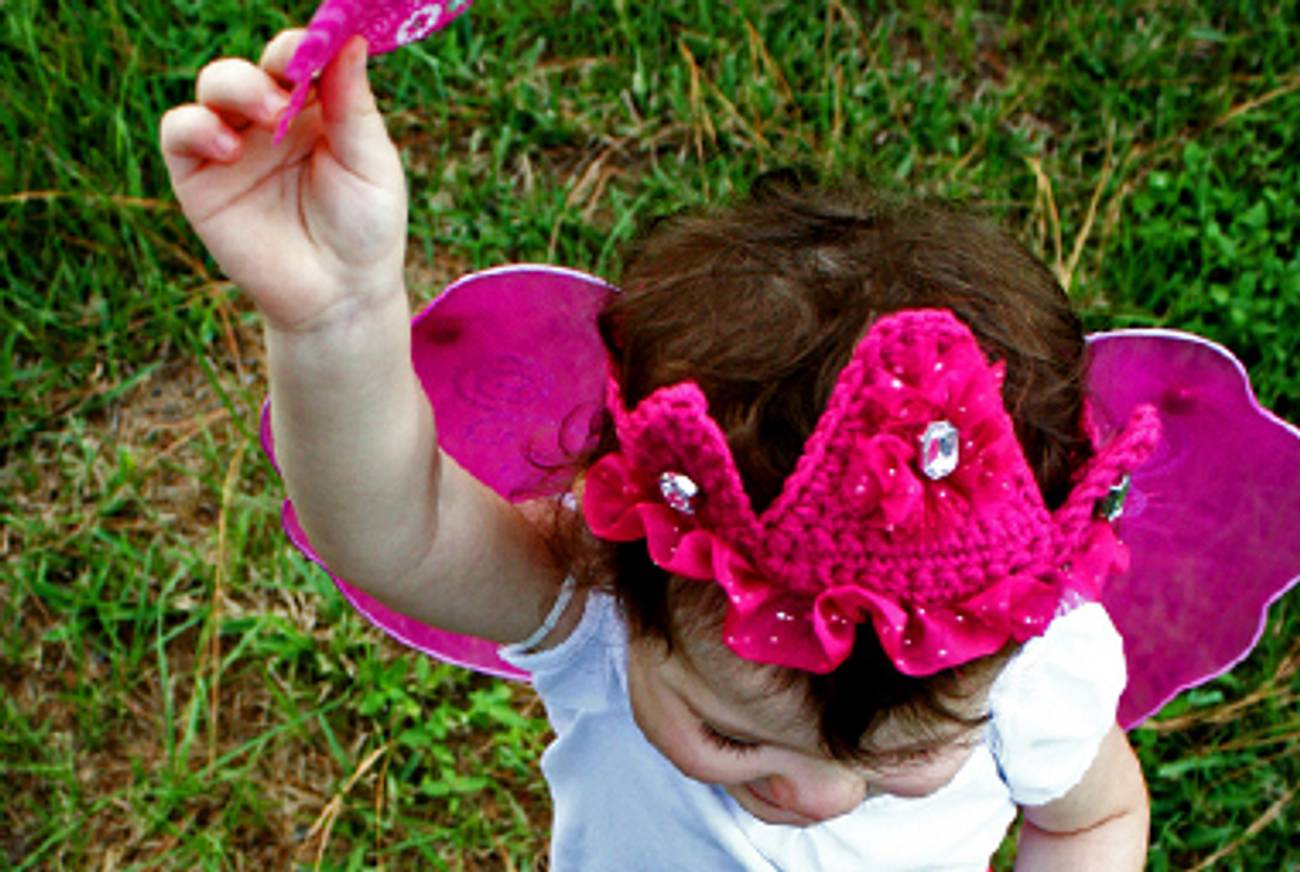Boy, Interrupted
Purim calls for costumes, and we’re fine with seeing little girls dressed up as boys. But a boy dressed as a girl makes us uncomfortable, thanks to stubborn ideas about gender roles. It shouldn’t.




My favorite Purim costume was Pharaoh. (Don’t fence me in with your narrow isolationist notions of confining oneself to villains of the Persian Empire.) My uncle Michael had given my mom a gorgeous gold-and-turquoise robe with navy embroidery around the neckline; it became my default dress-up outfit. Occasionally, I was Haman, because I enjoyed drawing a twirly mustache on my upper lip with an eyeliner pencil.
While most little girls see the megillah reading as an opportunity to bust out the Disney Princess garb, there are always a handful who get a kick out of being Haman, the way I did. But on Purim this year, which arrives Saturday night, there are likely to be very few, if any, little boys dressed as Esther.
Why? Because when little girls dress “boyishly,” everyone thinks it’s cute. I adored putting baby Josie and baby Maxie in Osh-Kosh engineer overalls and teensy black Converse high tops. If I’d had sons, would I have put them in pink onesies and glittery parachute pants?
Yet many parents do have what Sarah Hoffman, a Jewish writer who blogs pseudonymously, calls “Pink Boys.” (It’s the title of her forthcoming book). Whether a kid is growing up in Berkeleyest Berkeley, Calif., or in Hasidic Williamsburg, Brooklyn, the urge to be fabulous isn’t something entirely within the parents’ control. “Gender identity isn’t something we just impose on kids and expect them to suck it up, like eating vegetables or going to school,” Hoffman writes. “It’s part of who they are, whether that satisfies us as parents or not.” Sometimes, little boys who love dresses grow up to be gay. Sometimes they’re transgender. And sometimes a pretty dress is just a pretty dress. Parents needn’t jump to any assumptions about what a little boy’s love of tulle means, but they should listen to and respect the individual child’s desires.
“Don’t get ahead of yourself,” said Julie Holland, an assistant professor of psychiatry at the NYU School of Medicine. “The important thing is not to induce shame in your kid. It’s essential that kids feel they are OK, that they are loved and lovable.” She offered advice to parents whose sons want to wear dresses to school. “You can say, ‘In our culture, many people think that only girls should like pink, and that’s kind of silly. They think some toys and outfits are ‘boyish’ and some are ‘girlish.’ How do you think people will respond if you wear the dress to school?”
The trick is balancing your child’s safety with his or her self-expression. You have to find this balance without letting your own gender-issue mishegas get in the way and without making your kid feel judged and wrong. If your child’s teacher is supportive, the school is a nurturing place, and your son’s passion for silk charmeuse is implacable, why not let the kid wear a freakin’ dress? The issue, of course, is if the school environment isn’t supportive. “You don’t want to hurt him, and you don’t want the world to hurt him,” said Holland. “Which means the ultimate solution is to change the world, not your kid.”
That means if your kid really wants to wear dresses, you find allies within the school community to protect your child. If the kid is experiencing regular bullying, it may mean finding another school or homeschooling. “The path isn’t easy,” Holland added. “But your job as a parent is to, as much as you can, create a safe space for your kid.”
There has conveniently been a boomlet in children’s books about boys in dresses. I can think of four books published in the last year alone that address this issue. 10,000 Dresses, by Marcus Ewert, gorgeously illustrated by Rex Ray, is the story of a child named Bailey who looks like a boy but knows she is a girl inside. She dreams of wearing brilliant dresses made of crystals, rainbows, flowers, and windows, but her family refuses to acknowledge her true self. Ultimately she does find a supportive friend. Unfortunately, I think this book would baffle most little kids: Its use of pronouns is very confusing for kids who view the world in binary ways—the omniscient narrator assumes that the reader understands that Bailey is a she, despite looking like a he, but most kids won’t make that leap. The pictures are gorgeous, though, and I can see older children who are already familiar with transgender issues really loving the book. (Also fun: the blurb by fashion-designing Jew Isaac Mizrahi: “I love this book! If I had read it growing up, I might have felt better about my dress-wearing habit!”)
Then there’s Be Who You Are by Jennifer Carr, illustrated by Ben Rumback, a picture book based on the author’s own parenting experience raising a transgender child. And My Princess Boy by Cheryl Kilodavis, illustrated by Suzanne DeSimone, the story of a little boy named Dyson who likes to wear a tiara sometimes and jeans sometimes. Kids may be turned off by the illustrations, depicting people without faces (each character has a blank oval where the face should be, perhaps so everyone can project herself into the tale, but I think it just looks creepy). The book, by a mom who had a harder time than Carr in coming to terms with her child’s identity, pleads:
If you see a Princess Boy…
Will you laugh at him?
Will you call him a name?
Will you play with him?
Will you like him for who he is?
The one middle-grade novel in the bunch is The Boy in the Dress by David Walliams, a comedian who I am told is super-famous in England. The sweet, stylish spot illustrations are by Quentin Blake. The main character, 12-year-old Dennis, is a soccer-mad boy who loves to read Vogue and gradually admits to himself that he wants to wear dresses. The most popular, most gorgeous girl in school, on whom Dennis has a crush, befriends him and encourages him. There’s a lot of goofy, broad physical comedy (very British) and an ending that was, for me, too unrealistically rosy. But Josie, my 9-year-old, went crazy for the book, reading it over and over. I realized that for Jo, a child with an acute awareness of injustice, the book was a perfect fairy tale. She loved the ending precisely because it would never happen in the real world. What I saw as weakness she saw as wonderful.
Alternatively, as you consider the issue of dressing up—or cross-dressing-up—this Purim, you could always turn to our sages for advice. Deuteronomy may include a prohibition against a man wearing women’s clothes, but Rashi wrote that this kind of dress is wrong only when it leads to adultery, and Maimonides added that cross-dressing is wrong when it is for the purpose of idol worship. To these wise rabbis, the prohibition is against cross-dressing in order to do harm. If harm’s not the goal, as Rabbi Elliot Kukla and Reuben Zellman point out, quoting the Babylonian Talmud: “v’ein kan toevah”—there is no abomination here.
Will the world become more tolerant of boys in dresses? Holland offered a surprising analogy. “Until recently, peanut allergy wasn’t taken seriously,” she said. “Now every school has a policy, and everyone accommodates it. But parents had to educate people about the special needs of their sensitive kids. I’m not comparing cross-dressing to allergies. I’m just saying with education, change is possible.” And maybe that means one day we’ll see a lot more little boy Esthers.
Marjorie Ingall is a columnist for Tablet Magazine, and author of Mamaleh Knows Best: What Jewish Mothers Do to Raise Successful, Creative, Empathetic, Independent Children.
Marjorie Ingall is a former columnist for Tablet, the author of Mamaleh Knows Best, and a frequent contributor to the New York Times Book Review.